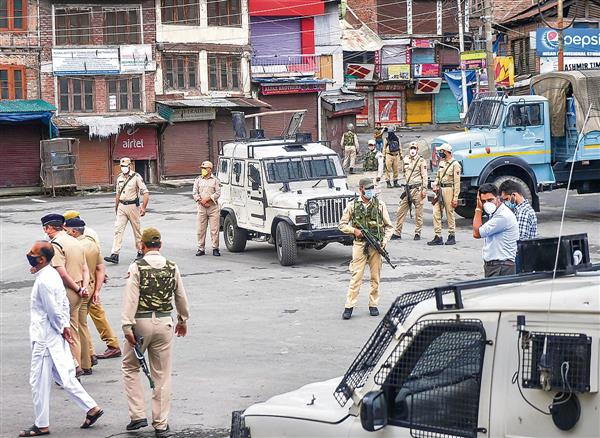
Underlying tension: Security forces have kept the lid on armed conflict in J&K.
Maj Gen Ashok K Mehta (retd)
Military Commentator
When Article 370 was abrogated on August 5, 2019, in J&K — concurrent with the longest lockdown in recent memory — shock and awe prevailed. Two extreme views took over — there would be a massive surge in insurgency and disaffection; and, as claimed by the government, terrorism would end, transforming J&K into a land of milk and honey. One year on, Kashmir is precariously poised between the two extremes, though the establishment’s forecast of the new normal of prosperity and development remains wide off the mark.
Take the flawed litmus test for measuring the state of insurgency in which the security forces have apparently performed impressively. The parameters of success are infiltration, attrition and recruitment of both local and foreign militants. Figures up to July 31 reveal that 150 militants were killed — 130 local and 30 foreigners, a 30 per cent uptick compared with the same period last year.
Approximately 200 terrorists are currently operational in J&K, down from the traditional number of 250 fighters for the last few years. Recruitment has dipped from 152 to 93, mostly local boys and infiltration reduced dramatically to 50 per cent which is a shade below the best (53 per cent) achieved in 2003 with the cooperation of General Pervez Musharraf after the two armies agreed to a ceasefire following Operation Parakram. Nearly 15 top-level terrorist commanders from Lashkar-e-Taiba, Jaish-e-Mohammad and Hizbul Mujahideen have been eliminated. As many as 504 overground workers were released on good behaviour bonds.
Further, due to the effective counter-infiltration grid, 90 per cent of recruits were unable to go to PoK for training. Pakistan’s ISI has asked its proxy army to lie low, even on recruitment. Similarly, sleeper cells in the Kashmir, Pir Panjal and Chenab valleys have been asked to mark time.
What has stopped significantly is the interdiction of security force operations by sympathisers and overground workers, returning bodies of slain militants to the families for public funerals and stone-throwing.
Still, violent incidents, mostly by stealth, have continued unabated despite the induction of 40,000 additional paramilitary forces last year. So much secrecy accompanied their arrival that proper synchronisation with the army was not feasible to streamline operations.
Digital connectivity restrictions have also hampered operations on both sides. But, as in the past, 250-300 terrorists are poised in PoK to cross the LoC. What has not been achieved in spite of the lockdown, the overwhelming presence of security forces and intelligence inputs is zero infiltration and the reduction of terrorist population to double digits. This magic mantra has eluded the Army for some time now and appears unachievable. But such statistics without a political plot are irrelevant.
In Pakistan, the removal of Article 370 came as a shocker. Even one year on, Islamabad has failed to fully internationalise the Kashmir dispute despite the active assistance of a P5 player and iron brother, China. Pakistan has issued its own map, showing the Indian part of J&K and Ladakh in Pakistan and marked it as disputed territory illegally occupied by India. A one-minute nationwide silence was observed on August 5 with Prime Minister Imran Khan visiting PoK.
Pakistan’s biggest worry is FATF which has forced the ISI to alter its Kashmir strategy. The Lashkar camp in Muzaffarabad has been relocated in the Neelum and Jhelum valleys. Jaish-e-Mohammad is being held on the leash after the Pulwama ambush. Azad Jammu and Kashmir Prime Minister Farooq Haider is upset with Imran Khan and General Bajwa’s passivity over the events in J&K. A march to the LoC by Kashmiri groups in PoK in October last year was disallowed.
A clear new development is China becoming an active third member to the Kashmir dispute, as last month’s joint statement from Hainan by Foreign Ministers Wang Yi and Shah Qureshi showed. While India may zealously internalise the Kashmir issue, it has been internationalised.
Insurgency in J&K is not a three- but seven-decade old scourge. Cross-border operations never ceased in 1947 and will not cease unless counter-insurgency is recognised as just one essential component of a political strategy. Successive governments in New Delhi have mistakenly attributed the armed conflict entirely to Pakistan deleting the indigenous element. They have also believed that once you get the terrorist body count in control, it will be open sesame.
The security forces, especially the army, have not only kept J&K intact geographically but also emotionally integrated large sections of rural Kashmiris with the mainland, especially after insurgency reignited in the 1990s. The Sadbhavna programmes of the Army went a long way in winning the hearts and minds of Kashmiris, efforts that dissipated over time.
I recall the winter of 1957 when I reported to my battalion in Uri. En route, I spent some time in Srinagar where while visiting the Dal Lake for the first time, I met a Kashmiri shikarawalla. He was friendly and striking up a conversation, asked: ‘What time is it in India?’ I returned to J&K in 1965, this time on the other side of Pir Panjal in the Mendhar valley. During the war, a wounded Pakistani soldier from the PoK asked me to wind his watch and enquired: ‘What time is it in India?’
But the failure of Pakistan’s Operation Gibraltar to foment an uprising was proof that most Kashmiris had made their choice to remain with India. After Pakistan’s defeat in 1971, and right up to 1990, when the LoC was dormant, opportunities were missed to politically resolve Kashmir. Instead, New Delhi was content with the Army’s domination of the security situation.
One year after the nullification of Article 370, while insurgency is nowhere near ending, security forces have kept the lid on the armed conflict, but in an eerie political vacuum in conditions of lockdown exacerbated by the Covid-19 pandemic, the absence of the promised development, joblessness and a Rs 40,000-crore hole in the economy, not to mention the myriad human rights violations. The tense situation on the LAC with China will have its negative impact on the security grid in J&K.
While the Army and the Special Forces have once again created conditions for resuming the peace process, New Delhi must engage with Kashmir’s pro-India constituencies for return to democratic politics, followed by addressing the external factor.
It cannot be wished away.
Join Whatsapp Channel of The Tribune for latest updates.




























